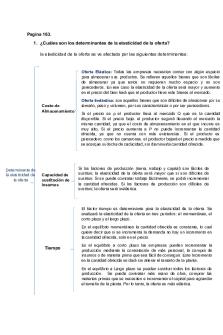Chapter 3 NUFS 163 PDF

| Title | Chapter 3 NUFS 163 |
|---|---|
| Author | Victoria Forrester |
| Course | Physical Finess & Nutrition |
| Institution | San José State University |
| Pages | 5 |
| File Size | 73.6 KB |
| File Type | |
| Total Downloads | 29 |
| Total Views | 133 |
Summary
NUFS 163 KIN 163 Lacey Atkinson ...
Description
02/10/2020
Kin 163 lecture Monday
Human energy CHAPTER 3 How is energy stored in the body? -
-
ATP Phosphocreatine Carbohydrates o Glucose o Glycogen Fats Proteins
Energy systems -
Intermediate o ATP-PCr Short term o Anaerobic metabolism (glycolysis) Long term o Aerobic metabolism (krebs cycle/oxidative)
Physiology of O2 uptake -
Lungs o Transfer O2 from atmosphere to the blood Cardiovascular o O2 rich blood to muscle tissue Metabolism o O2 is used to produce ATP
Fick Equation -
VO2= Q x (a-v O2 difference) Q cardiac output HR heart rate SV stroke volume
Cardiorespiratory Endurance -
Arteries going to the heart, veins going away from the heart Walls constrict and dilate Heart to arteries to arterioles to capillaries to venuole to veins, back to heart
Benefits to cardiorespiratory endurance exercise -
Maintain or increase hearts blood and oxygen supply Increase heart muscle function Strengthen heart contractions
-
Increase cavity size Increase blood volume Reduce blood pressure
Health benefits of physical activity -
Reduced: o Risk of cardiovascular disease o Cancer o Type 2 diabetes o Osteoporosis o Deaths from all causes
Immediate effect of cardiorespiratory exercise -
Increased levels of neurotransmitters; increased blood flow to the brain Increased HR and SV Increased ventilation Reduced blood flow to GI Increased ATP production Increased SBP
Long term effects -
-
-
-
Brain o Improved self-image o Cognitive function o Ability to manage stress o Enhanced learning, memory and sleep o Decreased depression and anxiety o Decreased risk of stroke Heart o Increased size o Increased resting SV o Lower resting HR o Reduction of heart disease and heart attack Lungs o Improved ability to extract oxygen o Reduced risk of colds and upper respiratory tract infections General o Increased sweat rate ands earlier onset o Decreased body fat o Reduced risk of colon cancer and certain other cancers o Increased blood volume and capillary density o Higher levels of HDL o Lower levels of triglycerides
-
-
o o o Muscle o o o Bones o o
Lower resting BP Increased ability of blood vessels to secrete nitric oxide Reduced platelet stickiness Increased number and size of mitochondria Increased storage of glycogen Improved ability to use lactic acid and fats as fuel Increased density and breaking strength bones, ligaments and tendons Reduced risk for low back pain, injuries, and osteoporosis
Estimate maximal oxygen consumption (VO2max) -
1 mile walk 3 minute step test 1.5 mile run-walk test
ACSM Cardiorespiratory recommendations -
3 to 5 days per week 40/50%-85% HRR or VO2R 20 to 60 minutes Use large muscles, rhythmic and aerobic
Heart rate reserve (HRR) -
220-age= maximal heart rate (MHR) MHR- resting heart rate = HRR HRR x 0.5 (50%) + RHR = low end of range HRR x 0.85 (85%) + RHR= high end of range
Volume of O2 reserve (VO2R) -
VO2- oxygen consumption at rest = VO2R VO2R x 0.5 (50%) + O2 at rest= low end VO2R x 0.85 (85%) + O2 at rest = high end Oxygen consumption at rest = 3.5 ml/kg/min
Heat cramps -
Cramping and spasms in muscle groups
Dehydration -
Increased body temp Decreased sweat rate, plasma volume, Q, VO2max, exercise capacity, muscular strength, and stores of liver glycogen For proper hydration during exercise o Drink 16-20oz of water 4 hours before exercise
o o
8-12oz of water 15 minutes before exercise During exercise more than 60 minutes, 3-8 oz every 15-20 minutes
Heat exhaustion -
Weak, rapid pulse Low bp Headache Dizziness Genera weakness Profuse sweating Pale face Psychological disorientation Normal or slightly elevated core body temperature
Heat stroke -
Medical emergency Rapid pulse and respiration Hot, flushed skin (dry or sweaty), red face Chills, shivering Very high or very low BP Confusion, erratic behavior Convulsions, loss of consciousness
Hypothermia -
Signs o o o o o o
Euphoria Slurred speech Slow, weak pulse Shivering collapse Unconsciousness Core body temperature ...
Similar Free PDFs

Chapter 3 NUFS 163
- 5 Pages

Economia Pagina 163
- 4 Pages

SCIU-163 Tarea U006
- 3 Pages

SCIU-163 Tarea U004
- 3 Pages

SCIU-163 Tarea U003
- 3 Pages

BIO 163 Chemistry Lab
- 15 Pages

NUFS 8 Exam 1 Study Guide
- 5 Pages

CGT 163 F20 Syllabus v20
- 10 Pages

Chapter 3 Chapter 3 Chapter 3
- 9 Pages
Popular Institutions
- Tinajero National High School - Annex
- Politeknik Caltex Riau
- Yokohama City University
- SGT University
- University of Al-Qadisiyah
- Divine Word College of Vigan
- Techniek College Rotterdam
- Universidade de Santiago
- Universiti Teknologi MARA Cawangan Johor Kampus Pasir Gudang
- Poltekkes Kemenkes Yogyakarta
- Baguio City National High School
- Colegio san marcos
- preparatoria uno
- Centro de Bachillerato Tecnológico Industrial y de Servicios No. 107
- Dalian Maritime University
- Quang Trung Secondary School
- Colegio Tecnológico en Informática
- Corporación Regional de Educación Superior
- Grupo CEDVA
- Dar Al Uloom University
- Centro de Estudios Preuniversitarios de la Universidad Nacional de Ingeniería
- 上智大学
- Aakash International School, Nuna Majara
- San Felipe Neri Catholic School
- Kang Chiao International School - New Taipei City
- Misamis Occidental National High School
- Institución Educativa Escuela Normal Juan Ladrilleros
- Kolehiyo ng Pantukan
- Batanes State College
- Instituto Continental
- Sekolah Menengah Kejuruan Kesehatan Kaltara (Tarakan)
- Colegio de La Inmaculada Concepcion - Cebu






